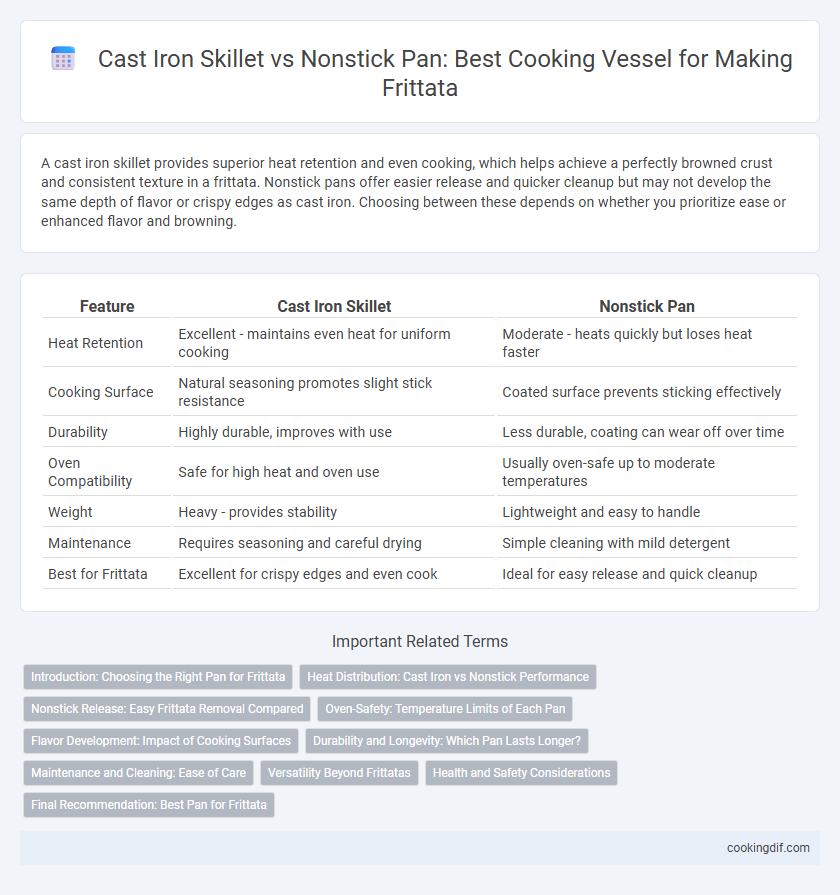A cast iron skillet provides superior heat retention and even cooking, which helps achieve a perfectly browned crust and consistent texture in a frittata. Nonstick pans offer easier release and quicker cleanup but may not develop the same depth of flavor or crispy edges as cast iron. Choosing between these depends on whether you prioritize ease or enhanced flavor and browning.
Table of Comparison
| Feature | Cast Iron Skillet | Nonstick Pan |
|---|---|---|
| Heat Retention | Excellent - maintains even heat for uniform cooking | Moderate - heats quickly but loses heat faster |
| Cooking Surface | Natural seasoning promotes slight stick resistance | Coated surface prevents sticking effectively |
| Durability | Highly durable, improves with use | Less durable, coating can wear off over time |
| Oven Compatibility | Safe for high heat and oven use | Usually oven-safe up to moderate temperatures |
| Weight | Heavy - provides stability | Lightweight and easy to handle |
| Maintenance | Requires seasoning and careful drying | Simple cleaning with mild detergent |
| Best for Frittata | Excellent for crispy edges and even cook | Ideal for easy release and quick cleanup |
Introduction: Choosing the Right Pan for Frittata
A cast iron skillet provides superior heat retention and even cooking, essential for a perfectly browned and tender frittata. Nonstick pans offer easy release and simpler cleanup but may lack the high-heat durability necessary for a crisp crust. Selecting the right pan depends on balancing cooking performance with maintenance preferences to achieve optimal frittata results.
Heat Distribution: Cast Iron vs Nonstick Performance
Cast iron skillets provide superior heat retention and even heat distribution, ensuring a perfectly cooked frittata with a crispy, golden crust. Nonstick pans heat up quickly but often deliver uneven heat, which can result in inconsistently cooked eggs and a less desirable texture. The dense construction of cast iron promotes slow, uniform cooking, making it the preferred choice for frittata enthusiasts seeking optimal heat performance.
Nonstick Release: Easy Frittata Removal Compared
Nonstick pans offer superior release properties that ensure easy removal of frittatas without sticking or breaking apart, preserving the dish's structure and presentation. In contrast, cast iron skillets require proper seasoning and maintenance to achieve a similarly smooth release, which can be inconsistent and lead to sticking. For consistent, effortless frittata extraction, nonstick pans provide a more reliable cooking surface ideal for delicate egg-based dishes.
Oven-Safety: Temperature Limits of Each Pan
Cast iron skillets excel in oven safety with high temperature tolerance, often exceeding 500degF, making them ideal for frittata recipes requiring intense heat and even cooking. Nonstick pans typically have lower temperature limits, around 350degF to 400degF, beyond which their coatings can degrade or release harmful fumes. Selecting a cast iron skillet ensures durability and superior heat retention for oven-cooked frittatas without the risk of damaging the cooking vessel.
Flavor Development: Impact of Cooking Surfaces
Cast iron skillets enhance frittata flavor development by providing even heat distribution and excellent heat retention, promoting a rich, caramelized crust. Nonstick pans prevent sticking but often produce a less flavorful, softer texture due to lower heat tolerance and insufficient browning. The choice of cooking surface directly influences Maillard reaction intensity, which is key to achieving the signature depth and complexity in frittata taste.
Durability and Longevity: Which Pan Lasts Longer?
Cast iron skillets offer exceptional durability and longevity, often lasting decades with proper care due to their robust material that resists warping and scratching. Nonstick pans typically have a shorter lifespan, as their coatings can degrade or peel over time, especially when exposed to high heat or metal utensils. For frittata cooking, investing in a cast iron skillet ensures a long-lasting, reliable vessel that maintains even heat distribution and improves seasoning with each use.
Maintenance and Cleaning: Ease of Care
Cast iron skillets require regular seasoning to maintain their nonstick surface and prevent rust, which involves applying oil and baking the pan, making maintenance more labor-intensive. Nonstick pans offer easier cleaning since food rarely sticks, allowing effortless washing with mild soap and water without special care. Choosing between the two depends on preference for durability and flavor development versus convenience and quick cleanup.
Versatility Beyond Frittatas
Cast iron skillets offer exceptional heat retention and even cooking, making them ideal for frittatas and versatile for searing, roasting, and baking a variety of dishes. Nonstick pans provide easy release and quick cleanup, suitable for delicate eggs but less effective for high-heat applications or developing a crisp crust. Choosing cast iron extends culinary options beyond breakfast, enabling dishes like skillet cornbread, roasted vegetables, and pan-seared meats, while nonstick pans excel in gentle cooking tasks and low-fat meals.
Health and Safety Considerations
Cast iron skillets provide excellent heat retention and can develop a natural nonstick surface with seasoning, reducing the need for synthetic coatings that may release harmful chemicals. Nonstick pans, often coated with polytetrafluoroethylene (PTFE), can degrade at high temperatures, potentially emitting toxic fumes that pose health risks during cooking. Choosing cast iron over nonstick ensures safer cooking with fewer chemical exposures while also offering durability and enhanced flavor development in frittatas.
Final Recommendation: Best Pan for Frittata
Cast iron skillets provide superior heat retention and even cooking, essential for achieving a perfectly set and evenly browned frittata. Nonstick pans offer easier release and simpler cleanup, ideal for delicate egg dishes with minimal added fat. For lasting durability and enhanced flavor development, a well-seasoned cast iron skillet is the best pan choice for frittata cooking.
Cast iron skillet vs nonstick pan for frittata cooking vessel Infographic

 cookingdif.com
cookingdif.com